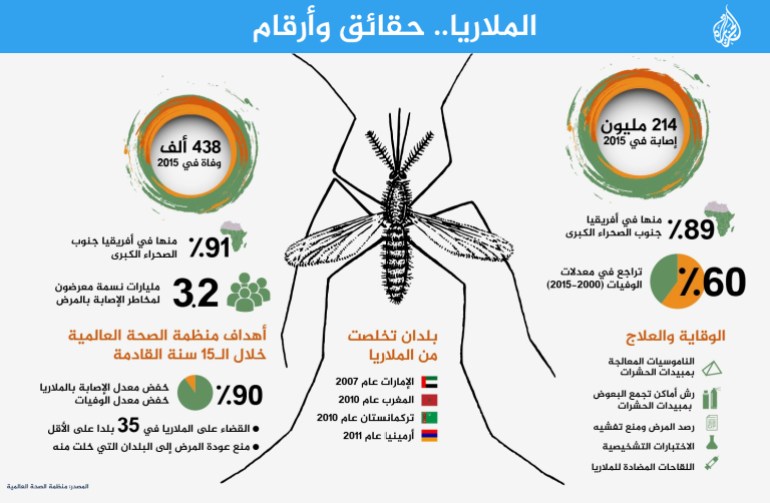Every year hundreds of thousands of people - mostly children in Africa - die from malaria, an ancient mosquito-borne epidemic, and its spread increased during the outbreak of the Corona epidemic.
The World Health Organization estimates that 627,000 people died from malaria in 2020, the latest year for which data is available, a 12% increase from 2019.
Half the world is in danger
Malaria threatens half the world's population, and sub-Saharan Africa, the eastern Mediterranean, the Americas and areas in the Pacific Ocean such as Papua New Guinea and the Solomon Islands are all at risk.
Reduce the spread of disease
Before 2020, the world was making steady progress in dealing with the transmission and treatment of malaria infection, especially through the use of insecticide-treated mosquito nets and effective examinations and drugs.
Its annual costs had fallen by 27% by 2017, compared to the turn of the century, while deaths had fallen by more than 50%.
And in June 2021, the World Health Organization certified that China was free of malaria, turning the page on a long battle that began in the 1940s, when the Asian country was recording 30 million cases annually.
China has not recorded any infection cases of local origin for 4 consecutive years.
setback
About 241 million malaria cases were recorded globally in 2020, 14 million more than the previous year, according to the World Health Organization.
About two-thirds of the additional deaths reported in 2020 were related to the disruption of prevention, examination and treatment measures related to malaria during the outbreak of the Corona virus.
Many patients have avoided going to hospitals, for fear of contracting Covid infection.
Malaria is a killer in Africa
95% of all malaria cases, and 96% of deaths from it, occur in sub-Saharan Africa.
Half of the reported cases worldwide were recorded in 2020 in 4 African countries: Nigeria (31.9% of the announced cases), the Democratic Republic of the Congo (13.2%), Tanzania (4.1%) and Mozambique (3.8%).
Victims of young ages
Children under the age of five are the group most at risk from the disease.
In 2020, about 80% of all malaria deaths on the African continent occurred in this age group.
Malaria symptoms
Symptoms of malaria include: heat, headache and muscle aches, followed by waves of cold, heat and sweating.
5 types of parasites
5 types of parasites cause malaria in humans, all transmitted through the bites of an infected female mosquito.
A parasite called Plasmodium falciparum causes the most deaths.
treatments
Several preventative treatments are available that can help reduce disease severity, avoid death and reduce transmission.
The World Health Organization says that the best, especially for P. falciparum, is the artemisinin-based combination therapy.
Preventive treatments are also highly recommended for pregnant women, infants living in high-risk areas, and travelers going to these areas.
Insecticide-treated bed nets are also a cheap and effective protective shield.
Vaccines
In October 2021, the World Health Organization recommended "widespread use" of the world's first child malaria vaccine in sub-Saharan Africa, after it conducted a review of a pilot program in Ghana, Kenya and Malawi.
Studies have shown that the RTS,S vaccine, manufactured by the British pharmaceutical giant GlaxoSmithKline, significantly reduced the death among children due to the infection of the parasite Plasmodium falciparum, the most prevalent in Africa.
More than one million children in Ghana, Kenya and Malawi have so far received at least one dose of the vaccine, the World Health Organization announced Thursday.

